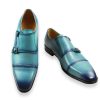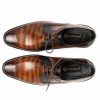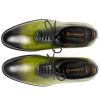Loafer Style Evolution: 100 Years from Fjords to Fashion
Loafer Style Evolution: A Century of Transformation
The fascinating loafer style evolution began in the harsh climate of Norwegian fjords, where fishermen needed practical footwear. This journey from functional workwear to high fashion icon spans continents, classes, and cultures. What started as simple moccasins transformed through royal commissions, American reinvention, and Italian luxury to become one of fashion’s most enduring symbols.
Origins: The Humble Beginnings of Loafer Style Evolution
The loafer style evolution began with Norwegian fishermen wearing “tesers” – simple leather slip-ons adapted from Native American moccasins. Shoemaker Nils Tveranger patented the Aurland moccasin in 1920, creating the first true loafer designed for harsh Nordic conditions.
Meanwhile in London, Wildsmith & Co. crafted bespoke house shoes for King George VI in 1926. This royal commission marked the first luxury iteration in the loafer style evolution, setting the stage for the shoe’s transformation from workwear to aristocratic leisure.
Learn more about traditional Norwegian footwear:
Norwegian Folk Art & Craft Association
1930s: American Reinvention in Loafer Style Evolution
In 1936, G.H. Bass partnered with Esquire magazine to create the Weejun (short for “Norwegian”). This pivotal moment in loafer style evolution saw the addition of the signature leather strap with diamond-shaped slit.
The “penny loafer” trend emerged when Ivy League students stored coins in the strap for payphones. This adaptation transformed the loafer from practical footwear to a campus status symbol, accelerating its style evolution.
Explore our collection of vintage-inspired loafers inspired by this era.
1950s: Luxury Transformation of Loafer Style
The loafer style evolution took a luxurious turn in 1953 when Gucci introduced the Horsebit design. Replacing the penny slot with an equestrian-inspired metal buckle, this iteration elevated loafers to high fashion status.
Worn by Hollywood stars and European elites, the Horsebit loafer represented a significant shift in loafer style evolution, blending Italian craftsmanship with international appeal.
Discover Gucci’s heritage:
Gucci Horsebit History
Cultural Impact: Loafer Style Evolution in Society
The loafer style evolution reflects broader cultural shifts:
- 1957 Sockless Scandal: Yale students sparked controversy by wearing Weejuns without socks to chapel
- 1980s Wall Street: Traders used Gucci loafers to mark elite club floors as “silent class warfare”
- Punk Revolution: Vivienne Westwood defaced tassel loafers as “trial trophies” against establishment
See how modern designers interpret these cultural moments in our contemporary loafer collection.
Material Innovation in Loafer Style Evolution
The loafer style evolution has always been driven by material innovation:
| Era | Innovation | Impact |
|---|---|---|
| WWII | Recycled tire rubber soles | Improved grip for naval use |
| 1960s | “Wet blue” chrome tanning | Supple leather for luxury models |
| 2020s | Algae-based foam & vegan leather | Sustainable production methods |
This continuous style evolution demonstrates how loafers adapt to technological advances while maintaining their core identity.
Penny vs. Horsebit: Icons of Loafer Style Evolution
| Feature | Penny Loafer | Horsebit Loafer |
|---|---|---|
| Origin | 1936, USA (Bass) | 1953, Italy (Gucci) |
| Key Feature | Leather strap with slot | Metal horsebit buckle |
| Cultural Meaning | Ivy League casual | Luxury sophistication |
| Modern Style | Cropped jeans, no socks | Tailored monochromes |
These two designs represent distinct paths in loafer style evolution, demonstrating how regional interpretations created global fashion icons.
Modern Loafer Style Evolution: Sustainability
Today’s loafer style evolution focuses on eco-conscious innovation:
- Chunky recycled soles reducing landfill waste
- Chrome-free tanning preserving waterways
- Algae-based foam decreasing carbon footprint
- Vegan leather alternatives from sustainable sources
Discover our commitment to sustainability: Eco-Friendly Footwear Initiative
Key Milestones in Loafer Style Evolution
1908
Norwegian fishermen wear “tesers” with tarred soles
1920
Tveranger patents Aurland moccasin
1936
Bass Weejuns debut, creating penny loafer
1953
Gucci introduces Horsebit loafer
1982
Michael Jackson wears Weejuns in Thriller video
2020s
Sustainable hybrids with chunky soles emerge
This timeline highlights the remarkable loafer style evolution across more than a century.
The Future of Loafer Style Evolution
The ongoing loafer style evolution continues to blend heritage with innovation. As we look to the future, key trends include:
- Gender-fluid designs expanding beyond traditional menswear
- Smart technology integration for comfort and performance
- Circular production models promoting sustainability
- Cultural collaborations celebrating global influences
“The loafer is the Everyman of footwear: humble in origin, limitless in adaptation. Its journey from fish docks to boardrooms reveals more about cultural evolution than any history book.”
This continuous style evolution ensures loafers remain relevant for future generations while honoring their remarkable history.












